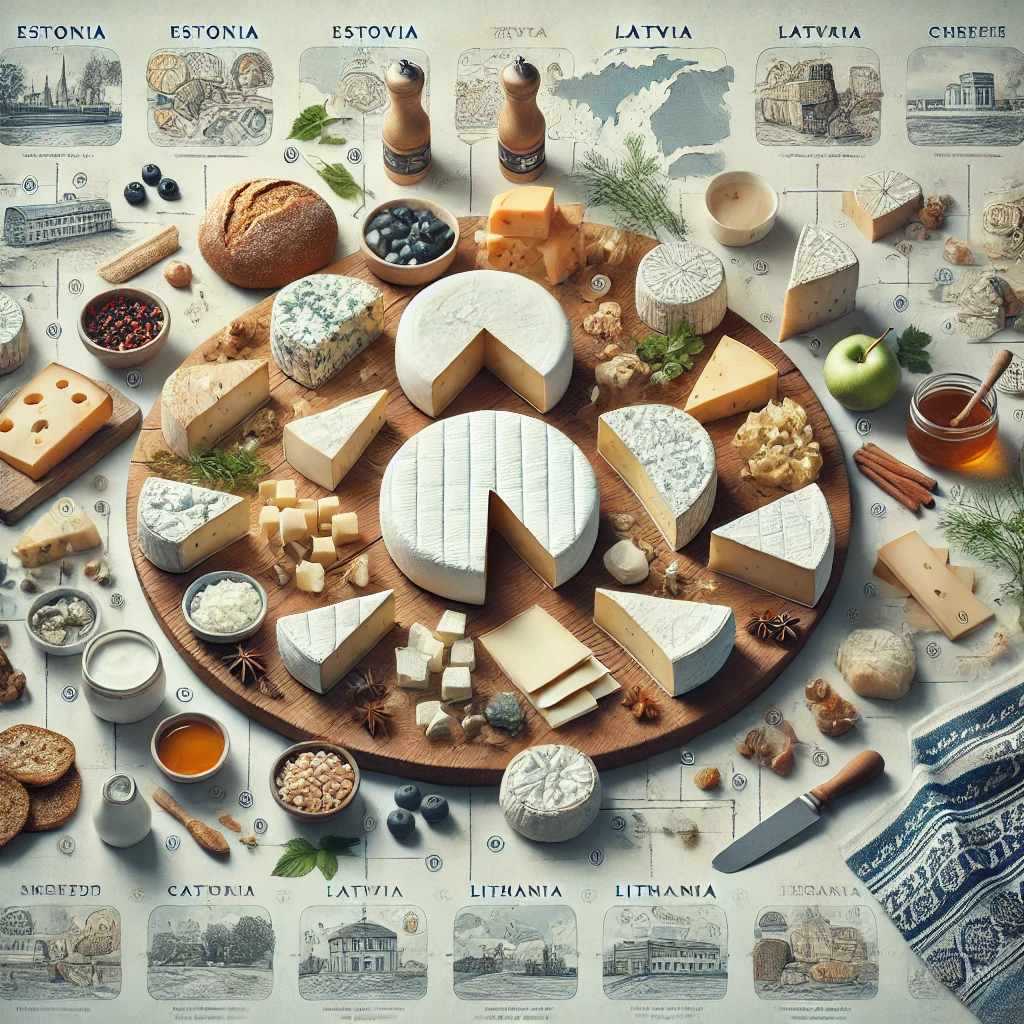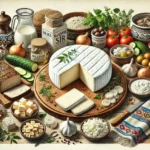The Baltic region, encompassing Estonia, Latvia, and Lithuania, is known for its forests, coastlines, cool climate, and deep-rooted agricultural traditions. While often overshadowed by Western European cheese cultures, the Baltic region has developed a rich and distinctive cheese heritage shaped by climate, history, and practicality.
Baltic region cheese is not defined by flamboyant aging or intense aromas. Instead, it reflects values of simplicity, nourishment, and versatility. From fresh farmer’s cheeses to semi-hard aged varieties, Baltic cheeses are designed for everyday use, long winters, and balanced flavors.
Geography and Climate Influence on Baltic Cheese Making
The Baltic climate plays a major role in shaping regional cheese styles.
Key Environmental Factors
-
Cool to cold temperatures
-
Long winters
-
Abundant pasture during short summers
-
Historical need for food preservation
These conditions favor:
-
Fresh and lightly fermented cheeses
-
Semi-hard, cellar-aged cheeses
-
Minimal use of spices or heavy salting
Baltic cheeses are generally clean-tasting, mild, and adaptable, making them ideal for daily meals.
Historical Roots of Cheese in the Baltic Region
Cheese-making in the Baltic region dates back centuries, closely tied to small farms and village life. Before industrialization, families relied on cows for milk, butter, and cheese, producing dairy primarily for household consumption.
Key historical influences include:
-
Indigenous Baltic food traditions
-
Scandinavian dairy practices
-
German and Eastern European techniques
Rather than copying foreign styles, Baltic cheesemakers adapted methods to local milk quality and climate, resulting in cheeses with a distinct Northern European identity.
Milk Sources Used in Baltic Region Cheese
Cow’s Milk (Primary)
Most Baltic cheeses are made from cow’s milk due to widespread cattle farming. This results in mild, creamy flavors.
Goat’s Milk (Limited)
Goat cheese exists but remains less common, often produced on small farms.
Mixed Milk (Occasional)
Some traditional cheeses use mixed milk, especially in rural settings.
The emphasis is on fresh, high-quality milk rather than complex processing.
Major Baltic Cheese-Producing Countries
Estonia
Estonian cheese culture favors practicality and freshness.
Common characteristics:
-
Fresh curd cheeses
-
Mild farmer’s cheese (kohupiim)
-
Semi-hard sliced cheeses
Kohupiim is widely used in both savory dishes and desserts.
Latvia
Latvia has a strong tradition of fresh and lightly aged cheeses.
Notable features:
-
Jāņu siers (caraway cheese)
-
Soft, farmer-style cheeses
-
Seasonal cheese production
Cheese is deeply connected to cultural celebrations.
Lithuania
Lithuania is known for both fresh and aged cheeses, often handmade.
Key traits:
-
Varškė (fresh curd cheese)
-
Smoked cheeses
-
Rustic farmhouse styles
Lithuanian cheese-making preserves many traditional techniques.
Common Types of Baltic Region Cheese
Fresh Curd Cheeses
These are the foundation of Baltic dairy cuisine.
Characteristics:
-
Soft and crumbly
-
Mildly tangy
-
Short shelf life
Used in desserts, dumplings, spreads, and baking.
Semi-Hard Cheeses
These cheeses are aged briefly to improve keeping quality.
Characteristics:
-
Firm, sliceable texture
-
Mild, nutty flavor
-
Pale yellow interior
Often eaten with bread or used in cooking.
Smoked Cheeses
Especially popular in Lithuania.
Characteristics:
-
Firm texture
-
Golden to brown exterior
-
Gentle smoky aroma
Smoking improves flavor and preservation.
Caraway and Herb Cheeses
Flavored cheeses are common across the region.
Characteristics:
-
Mild base cheese
-
Subtle spice or herb notes
-
Cultural and festive significance
Caraway seeds are especially iconic.
Taste Profile of Baltic Region Cheese
Baltic cheeses are known for restraint and balance.
Typical Flavor Notes
-
Mild dairy sweetness
-
Light acidity
-
Gentle nuttiness
-
Minimal sharpness
These cheeses are designed to complement meals, not overpower them.
Texture and Appearance
| Cheese Type | Texture | Appearance |
|---|---|---|
| Fresh | Soft, crumbly | White to cream |
| Semi-Hard | Firm, smooth | Pale yellow |
| Smoked | Dense | Browned rind |
| Flavored | Semi-firm | Seed-speckled |
Visual simplicity reflects their rustic origins.
Traditional Uses in Baltic Cuisine
Cheese is an everyday ingredient in Baltic households.
Common Traditional Uses
-
Spread on rye bread
-
Mixed into dumplings and pastries
-
Served with potatoes
-
Used in festive dishes
Fresh cheeses are especially common in breakfasts and desserts.
Cheese in Baltic Celebrations
Certain cheeses carry symbolic meaning.
Examples
-
Caraway cheese at midsummer festivals
-
Fresh curd cheese at family gatherings
-
Smoked cheese for special occasions
Cheese often represents abundance and hospitality.
Modern and Contemporary Uses
Modern Baltic cuisine is rediscovering traditional cheeses.
Contemporary Applications
-
Farm-to-table restaurants
-
Artisanal cheese boards
-
Fusion Nordic-Baltic cuisine
-
Vegetarian protein alternatives
Baltic cheeses fit well with modern clean-eating trends.
Best Food Pairings for Baltic Region Cheese
Bread and Grains
-
Rye bread
-
Barley bread
-
Crispbread
Vegetables
-
Potatoes
-
Beets
-
Cucumbers
Sweet Pairings
-
Honey
-
Berries
-
Fruit preserves
Simple ingredients enhance cheese flavor naturally.
Beverage Pairings
Baltic cheeses pair best with light drinks.
Beverage Options
-
Herbal teas
-
Light beer
-
Dry white wine
-
Kefir or fermented milk
Avoid overpowering beverages that mask delicate flavors.
Nutritional Value of Baltic Region Cheese
Baltic cheeses emphasize wholesome nutrition.
Nutritional highlights include:
-
High-quality protein
-
Calcium and phosphorus
-
Moderate fat levels
-
Minimal additives
Fresh curd cheeses are especially valued for daily nutrition.
Baltic Region Cheese vs Western European Cheese
| Feature | Baltic Cheese | Western European Cheese |
|---|---|---|
| Flavor | Mild | Strong |
| Aging | Short or none | Often long |
| Use | Daily meals | Specialty eating |
| Processing | Simple | Complex |
Baltic cheese prioritizes function and balance.
Buying and Storing Baltic Region Cheese
Buying Tips
-
Look for freshness dates
-
Choose local or artisanal producers
-
Avoid overly dry or sour cheese
Storage Tips
-
Refrigerate promptly
-
Store fresh cheese airtight
-
Consume within recommended time
Freshness is central to quality.
Cultural Importance Today
Baltic region cheese represents continuity and resilience. Despite political and economic changes, cheese-making traditions have survived through family knowledge and local agriculture.
Today, Baltic cheeses are gaining recognition for:
-
Sustainability
-
Authenticity
-
Minimal processing
They offer an alternative to heavily industrialized dairy products.
Why Baltic Region Cheese Deserves Global Attention
As global consumers seek:
-
Traditional foods
-
Clean labels
-
Regional identity
Baltic region cheese stands out as quietly exceptional. Its strength lies not in intensity but in honesty, heritage, and adaptability.
Conclusion
Baltic region cheese is a reflection of Northern Europe’s values—simple, practical, and deeply rooted in tradition. From fresh curd cheeses to smoked and semi-hard varieties, these cheeses nourish daily life while preserving cultural identity.
Exploring Baltic region cheese offers a deeper understanding of how climate, history, and community shape food traditions. For those seeking authenticity and balance in cheese, the Baltic region provides a rich and rewarding journey.
Frequently Asked Questions (FAQ)
What countries are included in the Baltic region for cheese?
Estonia, Latvia, and Lithuania.
Are Baltic cheeses aged?
Most are fresh or lightly aged; long aging is uncommon.
What milk is commonly used?
Cow’s milk is the primary milk used.
How do Baltic cheeses taste?
They are mild, clean, slightly tangy, and balanced.
Are Baltic cheeses good for everyday meals?
Yes, they are designed for daily consumption and versatile cooking.



